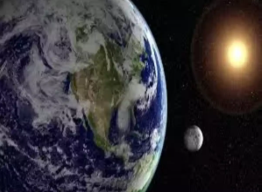Earth to Welcome a Temporary Mini-Moon for Two Exciting Months!
Introduction: A New Visitor in Earth’s Orbit
Earth is about to gain a temporary mini-moon for the next two months, an event that has fascinated astronomers worldwide. Unlike our permanent moon, this mini-moon is a small celestial body temporarily captured by Earth’s gravity before continuing its journey through space. Scientists are eager to study this cosmic visitor, as such occurrences are rare and provide valuable insights into near-Earth objects (NEOs).
What is a Mini-Moon?
A mini-moon, also known as a temporarily captured object (TCO), is a small celestial body that briefly orbits Earth before being ejected back into space. These objects are typically asteroids that drift close to our planet and, due to gravitational forces, get caught in Earth’s orbit. However, their stay is short-lived, lasting anywhere from a few weeks to a couple of years before they escape back into space.
How Do Mini-Moons Get Captured?
Mini-moons are usually asteroids or space debris that happen to enter Earth’s gravitational influence at just the right speed and angle. Instead of crashing into the planet, they are gently pulled into orbit. The gravitational pull of the Sun and the Moon also influences their trajectory, making their orbits unstable and temporary. Eventually, they either re-enter Earth’s atmosphere and burn up or continue on their path through space.
Past Mini-Moons Observed
Although rare, Earth has hosted mini-moons before. The most famous example is 2006 RH120, a small asteroid that orbited Earth for about 13 months between 2006 and 2007 before being ejected. Another recent case was 2020 CD3, a car-sized asteroid that orbited Earth for about three years before drifting away in March 2020. These observations help astronomers understand how celestial bodies interact with Earth’s gravitational field.
What Makes This Mini-Moon Special?
Scientists believe that this newly discovered mini-moon is relatively small, possibly the size of a washing machine or a small car. What makes it intriguing is its origin—while it is most likely an asteroid, some speculate that it could be artificial space debris from an old space mission. Determining its composition and origin will help scientists better understand objects that travel near Earth and their potential impact on space exploration.
How Will Scientists Study the Mini-Moon?
Astronomers will closely observe the mini-moon using telescopes and radar imaging to track its movement, size, and composition. By studying how light reflects off its surface, scientists can determine whether it is a natural asteroid or human-made space debris. Tracking its path also allows researchers to refine models of how near-Earth objects interact with our planet’s gravity.
Could a Mini-Moon Ever Impact Earth?
The chances of a mini-moon impacting Earth are extremely low. Because these objects are usually very small, they would likely burn up in the atmosphere before reaching the ground. However, studying their behavior helps scientists improve early warning systems for larger asteroids that could pose a real threat in the future.
The Future of Mini-Moon Discoveries
As telescope technology improves, astronomers expect to discover more mini-moons in the future. Advanced sky surveys and space missions could help identify these temporary visitors more frequently, providing opportunities to study them in greater detail. Understanding mini-moons also contributes to planetary defense strategies, helping us prepare for any potential asteroid threats.
Conclusion: A Fascinating Celestial Event
Earth’s temporary mini-moon is an exciting celestial event that offers a unique opportunity for scientific discovery. Whether it is a natural asteroid or space debris, its presence reminds us of the dynamic nature of space and our planet’s place in the universe. As scientists continue to study this mini-moon, we gain valuable insights into the ever-changing cosmos that surrounds us.


Leave a Comment